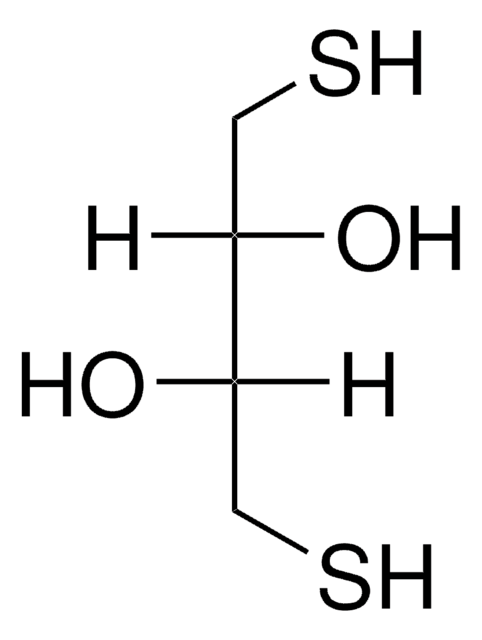85558
Spermidine
BioUltra, for molecular biology, ≥99.5% (GC)
Sinonimo/i:
SPD, 1,8-Diamino-4-azaoctane, N-(3-Aminopropyl)-1,4-diaminobutane
About This Item
Prodotti consigliati
Grado
Molecular Biology
for molecular biology
Livello qualitativo
Nome Commerciale
BioUltra
Saggio
≥99.5% (GC)
Condizioni di stoccaggio
(Tightly closed. Keep locked up or in an area accessible only to qualified or authorizedpersons.)
tecniche
ChIP: suitable
buffer exchange: suitable
Impurezze
DNases, none detected
RNases, none detected
insoluble matter, passes filter test
phosphatases, none detected
proteases, none detected
Indice di rifrazione
n20/D 1.479 (lit.)
pH
12.0-13.5 (25 °C, 1 M in H2O)
Solubilità
H2O: 1 M at 20 °C, clear, colorless
Densità
0.925 g/mL at 25 °C (lit.)
Anioni in tracce
chloride (Cl-): ≤50 mg/kg
sulfate (SO42-): ≤50 mg/kg
Cationi in tracce
Al: ≤5 mg/kg
As: ≤0.1 mg/kg
Ba: ≤5 mg/kg
Bi: ≤5 mg/kg
Ca: ≤10 mg/kg
Cd: ≤5 mg/kg
Co: ≤5 mg/kg
Cr: ≤5 mg/kg
Cu: ≤5 mg/kg
Fe: ≤5 mg/kg
K: ≤50 mg/kg
Li: ≤5 mg/kg
Mg: ≤5 mg/kg
Mn: ≤5 mg/kg
Mo: ≤5 mg/kg
Na: ≤50 mg/kg
Ni: ≤5 mg/kg
Pb: ≤5 mg/kg
Sr: ≤5 mg/kg
Zn: ≤5 mg/kg
λ
1 M in H2O
Stringa SMILE
NCCCCNCCCN
Assorbanza UV
λ: 260 nm Amax: 0.1
λ: 280 nm Amax: 0.05
Compatibilità
suitable for molecular biology
applicazioni
advanced drug delivery
genomic analysis
InChI
1S/C7H19N3/c8-4-1-2-6-10-7-3-5-9/h10H,1-9H2
ATHGHQPFGPMSJY-UHFFFAOYSA-N
Informazioni sul gene
rat ... Ppm1a(24666)
Cerchi prodotti simili? Visita Guida al confronto tra prodotti
Descrizione generale
Applicazioni
- as a component of chromosome isolation buffer
- as a component of transcription buffer
- as a component of homogenization buffer
Azioni biochim/fisiol
Caratteristiche e vantaggi
- Versatile and adaptable for a wide variety of laboratory and research applications
- Suitable for Molecular Biology and Biochemical research
- Free from DNase, RNase, NICKase, and protease
- Tested to confirm low levels of heavy metal contamination, ensuring suitability for various applications
- Tested for trace levels of Anions and Cations
Avvertenza
Risultati analitici
Altre note
Avvertenze
Danger
Indicazioni di pericolo
Classi di pericolo
Eye Dam. 1 - Skin Corr. 1B
Codice della classe di stoccaggio
8A - Combustible corrosive hazardous materials
Classe di pericolosità dell'acqua (WGK)
WGK 3
Punto d’infiammabilità (°F)
233.6 °F - closed cup
Punto d’infiammabilità (°C)
112 °C - closed cup
Dispositivi di protezione individuale
Faceshields, Gloves, Goggles, type ABEK (EN14387) respirator filter
Scegli una delle versioni più recenti:
Possiedi già questo prodotto?
I documenti relativi ai prodotti acquistati recentemente sono disponibili nell’Archivio dei documenti.
I clienti hanno visto anche
Protocolli
HPLC Analysis of Biogenic Amines on Ascentis® RP-Amide
Il team dei nostri ricercatori vanta grande esperienza in tutte le aree della ricerca quali Life Science, scienza dei materiali, sintesi chimica, cromatografia, discipline analitiche, ecc..
Contatta l'Assistenza Tecnica.









